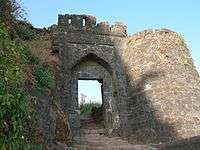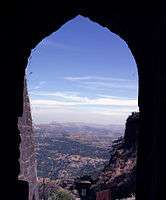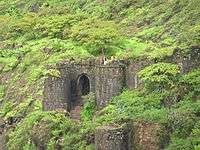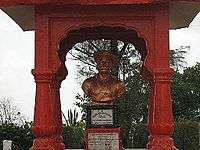Sinhagad
| Sinhgad- Kondhana | |
|---|---|
 Sinhgad fort | |
| Highest point | |
| Elevation | 1,312 m (4,304 ft) |
| Coordinates | 18°21′56.39″N 73°45′18.97″E / 18.3656639°N 73.7552694°ECoordinates: 18°21′56.39″N 73°45′18.97″E / 18.3656639°N 73.7552694°E |
| Naming | |
| Translation | सिंहगड (Marathi) |
| Geography | |
 Sinhgad- Kondhana Location of Sinhagad, Maharashtra | |
| Location | Pune, Maharashtra, India |
| Parent range | Sahyadri Range |
Sinhagad, Sinhgarh, or Sinhgad (The Lion's Fort), is a fortress located roughly 30 kilometres southwest of the city of Pune, India. Previously called Kondhana (Marathi: कोंढाणा), the fort has been the site of many important battles, most notably the Battle of Sinhagad in 1671. It was also strategically located at the centre of a string of other forts such as Rajgad, Purandar and Torna.
Perched on an isolated cliff of the Bhuleswar range of the Sahyadri Mountains, it is situated on a hill rising some 760 metres above ground level and 1,312 metres above mean sea level. Given natural protection by its very steep slopes, the walls and bastions were constructed at only key places; it has two gates – the Kalyan Darwaza in the south-east and the Pune Darwaza in the north-east.[1]
History

This fort has had quite a long history, It was called Kondana after the sage Kaundinya. The Kaundinyeshwar temple, the caves and the carvings indicate that this fort had probably been built two thousand years ago. It was captured from the Koli tribal chieftain, Nag Naik, by Muhammad bin Tughlaq in 1328 AD.

Shahaji Bhosale, as the commander of Ibrahim Adil Shah I, was entrusted with the control of the Pune region. His son Shivaji, however, refused to accept the Adilshahi and initiated the task of setting up Swarajya. He gained control of Kondana in 1647 by convincing Siddi Amber, the Adilshahi Sardar who controlled the fort, that he, the son of Shahaji Bhosale, could manage the fort's defences optimally. Bapuji Mudgal Deshpande played a key role in this activity. Adil Shah jailed Siddi Amber for this treasonous act, and schemed to get it back. He imprisoned Shahaji Bhosale for a concocted crime and informed Shivaji. In 1649, Adil Shah traded the fort for Shahaji's release. Shivaji Maharaj recaptured it in 1656, again with the help of Bapuji Mudgal Deshpande,who convinced the Fort commander by giving land in the newly created Shivapur village and peacefully gained control of the fort. This fort saw attacks by Mughals in 1662, 1663 and 1665. In 1664, Shahistekhan, the Mughal general, even tried to bribe the people of the fort to hand it over to him, but was unsuccessful. Through the Treaty of Purandar, it passed into the hands of the Mughal army chief Mirzaraje Jaysingh, in the year 1665. In 1670, Shivaji Maharaj re-conquered this fort and then it stayed under Maratha rule till 1689. After the death of Sambhaji, the Mughals regained control of the fort. The Marathas, headed by Sardar Balkawade, recaptured it in 1693. Chatrapati Rajaram took asylum on this fort during a Mogul raid on Satara but died on Sinhagad on 3 March 1700. In 1703 Aurangzeb conquered the fort. In 1706, it once again went into the hands of the Marathas. Pantaji Shivdev of Sangola, Visaji Chafar and the Pant Pratinidhis played key role in this battle. Then this fort remained with Marathas till 1818, when the British conquered it. British however took three months to capture this fort, which was longest it took them to win any fort in Maharashtra.[2]
Battle of Sinhagad

One of the most famous battles for Sinhgad was fought to recapture the fort by Tanaji Malusare,a Mard Maratha Koli and a general of Shivaji in March 1670. A steep cliff leading to the fort was scaled with the help of a monitor lizard named Yashwanti, colloquially known as a ghorpad. Thereafter, fierce battles ensued between Tanaji and his men, and the Mughal army headed by Udaybhan Singh Rathod a Rajput sardar, that had the fort at the time. Tanaji lost his life, but his brother Suryaji took over and captured Kondana.[3] There is an anecdote that upon hearing of Tanaji's death, Shivaji expressed his remorse with the words: "Gadh aala, panh sinha gela" - "We gained the fort, but lost the lion". The name Sinhagad, though, pre-dates this event, and can be seen in written communiques from the era. A bust of Tanaji has been established on the fort in memory of his contribution to the battle.[2]
Other details

Sinhagad Fort is located to the southwest of Pune at a distance of 25 km. The fort was strategically built to provide natural protection. There are only two gates to enter the fort, the Kalyan Darwaza and Pune Darwaza which are positioned at the south east and north-east ends respectively. Some of the information available at this fort suggests that the fort could have been built 2000 years ago. The caves and the carvings in the Kaundinyeshwar temple stand as proofs for the same. In 1328 AD, Muhammad bin Tughlaq captured the fort from Nag Naik, Koli tribal chief. Since this time, many rulers attempted to capture the fort and it went into different hands at regular intervals. Shivaji, the ruler of Marathas took over the fort in 1647. Mughals gave a tough fight in capturing the fort, but Marathas never let the fort stay under any one for a long time. The fort was captured by other rulers and recaptured by Marathas at regular intervals, until the British finally captured it in 1818. The fort is also significant for holding the memorials of Tanaji Malusare and Rajaram, younger son of Shivaji. Tanaji was a general of Shivaji who lost his life in the Battle of Sinhagad. Twentieth Century history reveals that one of the renowned Indian freedom fighter Lokmanya Tilak erected a bungalow above the fort.
Culture
Parts of the once extensive fortification are now in ruins, but visitors can get a sense how the fort acted as an active military outpost. It is a popular weekend destination for many residents of Pune, with some enthusiasts trekking to the top of the fort from the base near Sinhgad village. The site also houses a memorial to Tanaji as well as the tomb of Rajaram, Shivaji's younger son, who also died here. Visitors can see the military stables, brewery and a Kali (goddess) temple along with a Hanuman statue much to the right side of the temple, as well as the historic gates. The fort is also part of training at National Defence Academy, Khadakwasla. Cadets from the academy are regularly sent on a hikes and runs from NDA to Sinhagad in full battle gear to build endurance and stamina. The fort also houses a television tower for broadcasting local TV signals. Currently some not much well constructed rooms and bungalows are available for staying at the top.[4] Non-vegetarian food, alcoholic drinks and smoking are strictly prohibited on the fort.[5]

There is a steep and narrow two lane road from the base of the fort to the top. In between the road is in bad condition and currently getting reconstructed. Also you have to pay vehicle toll at the base of the fort to continue your journey to the top. The local municipal transport service, the PMPML, runs buses every hour from Shaniwarwada and Swargate − to the Sinhagad foothills at Donje village. The climbing route from either side of the fort can be covered in around an hour, however it gets slippery in the rainy season. Shared taxi services to the base as well as the top of the mountain are also available.
References
- ↑ "Sinhagad Fort". Retrieved 2012-05-18.
- 1 2 Verma, Amrit. Forts of India. New Delhi: The Director, Publication Division, Ministry of Information and Broadcasting, Government of India. pp. 83–86. ISBN 81-230-1002-8.
- ↑ Sudheer Birodkar. "Chattrapati Shivaji Maharaj and the National Revival under the Marathas". hindubooks.org.
- ↑ http://www.pravasivishwa.com/locations/show_english/65
- ↑ "Ban on partying on Sinhagad fort". TNN. The Times of India. 25 March 2015. Retrieved 4 July 2015.
See also
| Wikimedia Commons has media related to Sinhagad. |